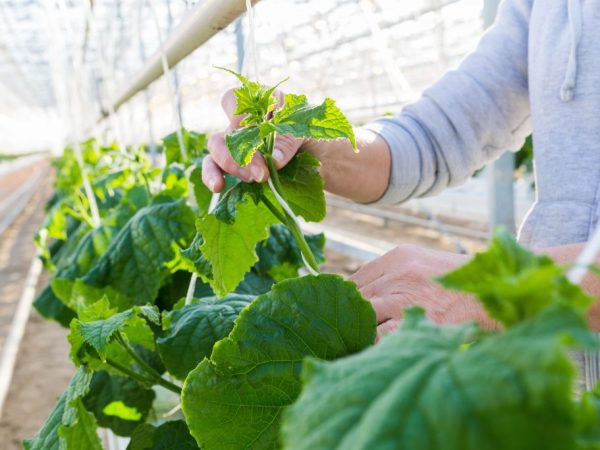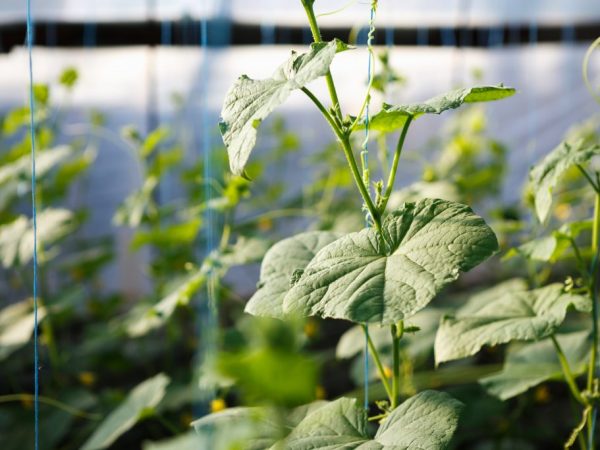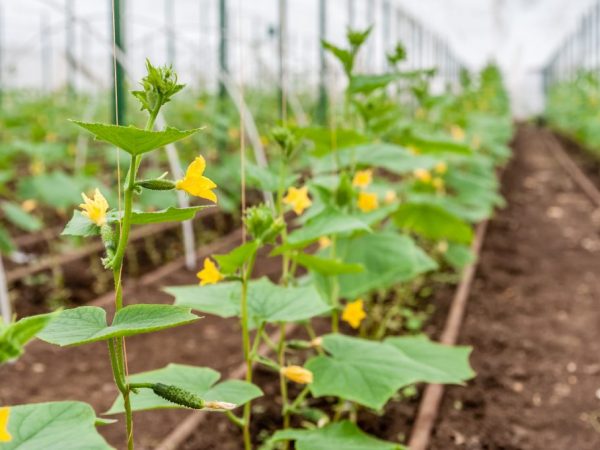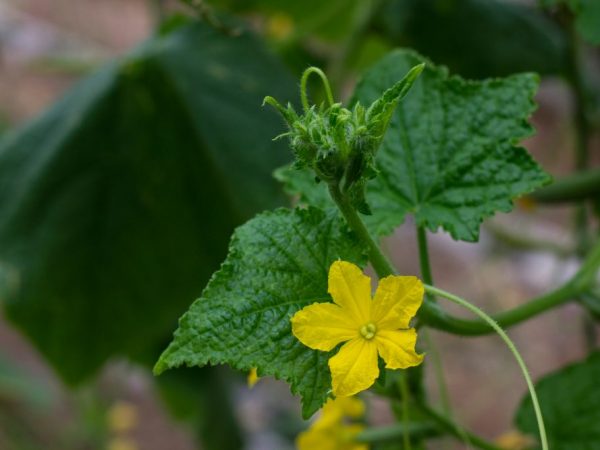Planting cucumbers in a polycarbonate greenhouse
Many summer residents grow cucumber culture in greenhouses. Proper planting of cucumbers in a polycarbonate greenhouse and proper follow-up care is the key to a good future vegetable harvest.
- Greenhouse preparation
- Soil preparation
- Warming of beds
- Dung beds
- Compost beds
- Greenhouse-friendly varieties
- Landing rules
- Planting classic varieties
- Planting parthenocarpic hybrids
- On round beds
- Greenhouse landing
- Sowing with seeds
- Transplanting
- Possible problems
- Features of the microclimate
- Temperature indicators
- Lighting
- Humidity
- Air circulation
- Follow-up care
- Watering
- Lure
- Formation of bushes

Planting cucumbers in a polycarbonate greenhouse
Greenhouse preparation
In a polycarbonate greenhouse, cucumbers can be grown almost all year round, but the quality of the soil is of no small importance for harvesting for a long time. Among the requirements for the soil in the greenhouse for planting cucumbers:
- looseness of the soil,
- good water and air permeability,
- corresponding indicators of acidity.
Demanding for favorable growing conditions, cucumber culture reacts to the remnants of pathogenic bacteria left after vegetables grown last season. Therefore, if plants damaged by diseases were noticed on the beds, it is better and correctly to disinfect the greenhouse with a lime solution and paint it with whitewash before planting a new crop.
Soil preparation
You can prepare the land for planting cucumbers in a polycarbonate greenhouse yourself. It is enough in the spring to remove a soil layer of 0.25 m in a field, meadow or forest glade, keep it covered indoors for 2 months, then move it to the sun, covered with a film. This technology of soil preparation for planting cucumbers makes it possible to ripen the soil and cleanse itself of bacteria and parasites.
An ideal soil for a cucumber culture will be such a soil, which consists of equal shares of humus, turf and peat with an acidity of not more than 6.5, which is regulated by adding limestone to the soil.
The beds for planting are made a little elevated, approximately 20-25cm in height. Bleach can protect the soil from pests, fungi and infectious diseases, with which, before planting cucumbers in a greenhouse, the entire earth is sprayed by spraying.
Warming of beds
When it is supposed to plant cucumbers in a polycarbonate greenhouse at an early date or for the purpose of growing vegetables in the cold months, so-called warm beds are made.
Dung beds
The bed, insulated with manure, simultaneously acts as a fertilizing of vegetable crops. In its arrangement, cow dung diluted with horse manure is used. The mixture is laid out in the beds, covered with fertile soil 0.2-0.25 m thick from above, and the entire earthen pad is spilled abundantly with water. after planting cucumbers in a greenhouse, it is recommended to water such a warm bed for 30 days and it is better to prevent overheating of the soil. Otherwise, you may encounter burnt cucumber seeds and root systems.
Compost beds
A bed insulated with compost can be an alternative to manure when the latter could not be found. They equip such a warm bed of tops, leaves, wood shavings and sawdust. An important condition in this case is the freshness of the selected organic matter, since the amount of heat released to it depends on this.
Most often, beds for planting cucumbers in a greenhouse, insulated with compost, are suitable for regions with warm weather, since the release of heat from them is less intense, unlike beds with manure.
Greenhouse-friendly varieties

You need to choose the right variety
For planting in a polycarbonate greenhouse, not all varieties of cucumbers are suitable. Consider suitable varieties:
- For greenhouses, those that do not need pollination for fruiting are suitable. These include ABC-f1, Teremok-f1. When planting such self-pollinated varieties, it should be borne in mind that they do not like sudden changes in watering and fluctuations in temperature conditions.
- In conditions of limited illumination, when growing cucumbers in a greenhouse, you should choose those varieties that are shade-tolerant and do not suffer from a lack of light and heat. These include Ladoga-f1, Northern Lights-f1, Olympiada-f1, Relay-f1.
- For unheated greenhouses, it is recommended to select such hybrid varieties of cucumbers that are characterized by moderate or weak branching. These include Ant-f1, Cupid-f1.
- For greenhouses with heating, cucumber varieties are suitable, which regulate the branching process independently. Among them, for example, Thumb Boy.
Suitable greenhouse cucumbers, depending on the purpose:
- for the preparation of salads, Tamerlane-f1, Makar-f1 are applicable,
- for conservation, Lord-f1, Acorn-f1 are suitable.
For each of the varieties, the timing of planting cucumbers in a polycarbonate greenhouse may vary.
Landing rules
A correctly selected scheme for planting cucumbers in a greenhouse assumes a distance at which vegetables will grow and develop comfortably. Seeds of a number of cucumber varieties in the instructions contain information on the required optimum width between the rows. Densely planted cucumber bushes require more careful maintenance, which is more difficult in this case. It is difficult to harvest from such closely spaced plants, especially when small-fruiting varieties are grown. When they try to plant cucumbers in a polycarbonate greenhouse too close to each other, this can threaten the plant with less sunlight and an excess of moisture.
A large amount of moisture leads to disease and decay of the root system.
Wide distances between cucumber bushes are also not recommended. When you plan to plant cucumbers in a polycarbonate greenhouse widely, do not forget that with this planting scheme, the cultivated area is lost and the efficiency of their use in the limited space of the greenhouse decreases. Suboptimal planting lowers yields.
Planting classic varieties
For classic cucumber varieties, the scheme for planting cucumbers in a polycarbonate greenhouse with dimensions of 0.5 * 1.0m involves planting:
- two-line, or in two tracks of 4 rows, often located 2 in the center and 1 each at the edges,
- one line, or one track.
The optimal width for the beds will be in the range from 0.9 to 1.2 m. the distance between the rows of cucumber bushes varies from 0.5m to 0.6m. Short-leaved cucumber varieties are planted every 10 cm, long-leaved ones - every 20 cm.
Planting parthenocarpic hybrids

When disembarking, you need to keep a distance
The planting scheme of parthenocarpic cucumber hybrids is the same as for classic varieties of cucumbers for planting in a greenhouse, only the width of the beds for them should be at least 1.5-1.6 m, the minimum distance between rows is from 0.6 m, and cucumber bushes are not planted closer 0.3-0.35 m from each other.
On round beds
You can plant cucumbers in a polycarbonate greenhouse on a so-called round bed.For this:
- a pole is placed in the central part of the allotted fertile area,
- twine guiding ropes are attached to the pole in an amount corresponding to the number of bushes planned for planting,
- cucumber seedlings are planted in a circular direction every 0.15-0.2m.
In the process of growing a vegetable crop, the lashes will begin to twine around rope cords, forming a kind of cone. The development of vegetables will be heaped, and this will facilitate the subsequent harvest.
Greenhouse landing
Growing cucumbers in greenhouse conditions includes several main stages.
Sowing with seeds
When cultivating a cucumber culture in a polycarbonate greenhouse, it is not at all necessary to pre-grow seedlings. You can sow cucumbers in a greenhouse by seeds directly into the soil. Especially often gardeners of the southern regions resort to this method, when, starting in March - early April, they can safely plant seeds in a greenhouse.
Experienced summer residents who have insulated greenhouses with sufficient illumination, even in the Moscow region, plant cucumber seeds in February.
After 20 days, the sprouted cucumber sprouts are transplanted according to one of the more suitable schemes for planting cucumbers in a greenhouse.
Transplanting
With the seedling method, planting cucumbers in a polycarbonate greenhouse for gardeners begins in early April on warm beds or in May, if there is no additional heating of the soil, subject to a number of precautions:
- the soil must be warmed up to 18 'before planting,
- it is advisable to plant seedlings together with the soil in which they grew, placing them strictly vertically, seedlings that are too elongated in height are sprinkled with a mixture of peat and sawdust in equal proportions to the level of cotyledon leaves,
- It is recommended to water the planted seedlings based on the length of the root, for each centimeter of which there is 1 liter per 1 square meter of sown area.
Many gardeners use the method of dropping, in which the earth is pounced on the stem. This stimulates the growth of lateral shoots and strengthens the root system of the cucumber. However, in the middle lane and in the north of the country, this does not apply, since with a short growing season for a vegetable crop, the process of developing vegetables is better than putting out additional roots and shoots.
Possible problems
Immediately the next day, you can face the consequences of a violation of the planting technology, when the foliage of the seedlings turned white from the edges. There can be two reasons for this:
- cold soil, it becomes a factor contributing to rotting of the root system of young seedlings, this can be corrected by irrigation with warm water with potassium permanganate and a subsequent increase in the temperature regime in the greenhouse,
- the second reason may be signs of an infected plant, in this case nothing remains but to remove the planted bushes and disinfect the soil.
Features of the microclimate

Microclimate plays a huge role in plant development
In a closed greenhouse, when planting cucumbers and in the process of further care for them, an optimal microclimate must be established.
Temperature indicators
The temperature in the greenhouse when growing cucumbers should be stable, without sudden fluctuations, within 25 '- 28'. For grown and matured cucumber bushes, it is permissible to decrease it to 18 'and increase to 30'.
Lighting
Of no small importance indoors is lighting, which is maintained at the required rate in autumn and winter by using additional sources of artificial light.
Humidity
With an increase in the temperature degree in the greenhouse, it is necessary to increase the humidity level, which on a hot day should be at least 85%. It is possible to increase the abundance of moisture in the greenhouse by watering the paths with the subsequent creation of a greenhouse effect with the doors closed in the greenhouse for an hour.
Air circulation
Ventilation of a closed greenhouse provides air access, which does not pass well through artificial polycarbonate. In the warm season, it is recommended to keep the vents of polycarbonate greenhouses open, but having done this on one side of the structure, so as not to create drafts.
Follow-up care
Careful care of cucumber bushes in the greenhouse begins immediately when the seedlings are planted in the greenhouse or when the first shoots appear after sowing the seeds.
Watering
Cucumbers should be watered in greenhouse conditions according to certain rules:
- before the first ovaries, the frequency of watering is once every three days, the grown cucumber bushes with the formed ovaries are watered every day,
- use warm water,
- the irrigation rate for each square meter of sown area is from 5 to 7 liters.
From time to time, gardeners arrange warm showers for their cucumbers, making sure that no water drops remain on the foliage at night. After the watering procedure, the ground near the base of the bushes is loosened to avoid rotting.
Lure
The feeding of cucumbers in the greenhouse is most often carried out by organic compounds and, first of all, among them - manure. In addition to it, they use mineral compositions, feeding cucumber bushes at least 5 times during the greenhouse season:
- primary feeding takes place before flowering with potassium sulfate (20g), superphosphate (30g), urea (15g) per ten-liter water volume,
- in the process of flowering, the bushes are watered with manure solution,
- in clear weather, root bait is carried out,
- on cloudy days, foliar spraying of leaves with potassium salt (8 g), superphosphate (10 g), saltpeter (5 g) per ten-liter water volume is used.
Formation of bushes
In greenhouse cultivation, one of the important points is the formation of cucumber bushes, because a garter that is late in time causes a decrease in the amount of foliage and reduces productivity.
When planting cucumbers in a polycarbonate greenhouse using the seedling method, vertical trellises are installed immediately with the planted bush. Rope twines are tied at a height of about 2 meters. The scheme for the formation of bushes includes several stages:
- the initial garter when forming cucumber bushes into one stem is done under the second or third leaf,
- in plants with 7-8 leaves in the third and fourth nodes, the branches are removed, then the lateral shoots are pinched,
- pinch 2-3 vegetables or leaves higher along the stem.
When the end of the trellis is reached, the cucumber lash is twisted around the trellis attachment, it is pinned and tied up.


